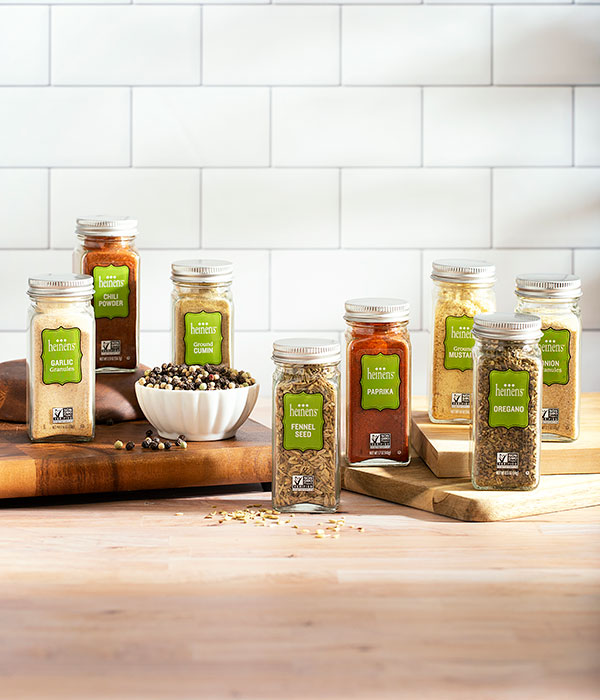A Chef’s Guide to Cooking with Spices

The following information was provided courtesy of local cookbook author and chef, Carla Snyder. Learn more about Carla at Ravenouskitchen.com.
Chefs know that spices make the world a better tasting place. Where would we be without the taste of cinnamon in apple pie, cumin in Texas chili or golden turmeric in chicken tikka masala? But many home cooks aren’t sure how to use spices to their best advantage and so tend to shy away from using them. The truth is, with a few tips you can successfully incorporate the bold flavors of spices into simple everyday meals. Let’s get started.
What are Spices?
It’s hard to know the potency and aroma of spices at the point of purchase since they are sealed in jars, but spices should be brightly colored and, once opened, should smell vibrant. As they age and oxidize, they go dull in taste as well as color. Look at the expiration dates on the jars for an idea of how long they will last, but know that once opened, most ground spices are at their peak for only 6 months. It’s best to purchase ground spices in the smallest amount possible to use them quickly.
Whole spices will last 3 times longer than ground due to the fact that the oils and flavor dissipate quickly once ground and exposed to air. Some spices, like nutmeg, are best purchased whole and ground on a fine grater, like a microplane, each time you use it. Whole black peppercorns are another spice that is best freshly ground in much the same way that freshly ground coffee is always the most flavorful.
How to Store Spices
Though flavor and quality will diminish over time, it’s possible to prolong the freshness of your seasonings with proper care and storage. Follow these 5 tips to ensure your spices last as long as possible.
- They may look pretty in clear glass jars on your windowsill but spices keep best in a cool, dark place.
- Don’t store them near the stove or oven, as the heat will age them more quickly.
- It’s also a good idea to add the date the spice was opened to the jar using a sticker or permanent marker. That way, you will have a clue as to its strength and can pitch it when it no longer smells quite as vibrant, or when the color fades.
- Make sure that the lids are tightly closed.
- Don’t add the spice from the jar over a simmering pot as the moisture from the steam can cause the spice to pack and not flow freely.
How to Organize Your Spice Cabinet
An organized spice cabinet is a better used spice cabinet. Keep spices and herbs that you use most often within easy reach. Tiered plastic spice racks work well, as does a small Lazy Susan. Make sure none are invisible in corners so you don’t mistakenly buy more. Bundle lesser used spices and herbs in small cardboard or plastic containers according to their use, such as the following most commonly used herbs and spices:
- Savory Herbs and Spices: oregano, thyme, basil, sage, rosemary, dill, cumin, garlic powder, curry powder, Italian seasoning, etc.
- Sweet Spices for Baking: cinnamon, allspice, clove, ground ginger, mace, poppy seed
- Heat and Pepper: peppercorns, paprika, cayenne, chili flakes, chili powder, lemon pepper
- Salts and Flavored Salts: sea salt, kosher salt, pink Himalayan salt, Great Lakes steak seasoning, poultry seasoning, garlic salt, onion salt
This way it’s easy to pull out a grouping of spices that you are more likely to use together, plus, no more spice jars falling out of the cupboard as you search.

How to Grind Whole Spices
A pepper mill is an inexpensive tool that will reward you with spice and flavor for years on end, but other whole spices require a mortar and pestle to unlock their potential. Another option is an inexpensive spice or coffee grinder dedicated to grinding only spices (unless you enjoy cumin scented coffee). The following spices can be purchased whole, but you can also buy them ground. Just use them up more quickly.
- Cumin: Used in Mexican and Indian dishes
- Black Peppercorns: Used in everything (you will never go back to pre-ground pepper)
- Coriander: Used in Mexican, Thai and Chinese dishes
- Nutmeg: Used for baking and some savory dishes
- Fennel: Used in Italian dishes and some baked goods
- Anise Seed: Used in Italian dishes and some baked goods
- Mustard Seed: Used in many cuisines to add heat and spice
- Dried Chilies: Used in Mexican, Thai and Chinese dishes
- Bay Leaves: Used in soups and stews from all cuisines
- Cardamom: Used in Indian dishes
- Celery Seed: Used in pickling preparations
The best way to clean a spice grinder is to use a small piece of bread to wipe out the stuck on powdered remains of the spice. It is remarkable how well this works. If you are using a mortar and pestle, just rinse it with water and air dry. Using soap may leave a residue that could affect the flavor of your ground spice. Definitely not a good thing.
Tips for Cooking with Spices
- If you want the best flavor from spices, toast them whole over medium heat in a dry skillet, tossing them around for a few minutes to release their aromatic oils. Then, let them cool before grinding. I often toast already ground spices, such as turmeric and cinnamon, which get a flavor boost from the heat. Just be careful not to burn them.
- If making a rice or vegetable dish with spice, the best way to incorporate the flavor is to cook the ground spice or dried herb in oil or butter before adding the main ingredients. The heat and fat allow the spice to bloom and, as a consequence, will incorporate that flavor throughout the dish more completely. It’s best to add spices and dried herbs early in the cooking process rather than later. Fresh herbs, are added at the end.
- If you are doubling a recipe, it’s not necessary to double the spices or dried herbs. If you would use 1 tsp. in a single recipe, 1 1/2 tsp. are appropriate to use in a doubled recipe.
- If you want to substitute dried herbs for fresh, use 1 tsp. dried herbs for every Tbsp. of fresh and remember to add them earlier in the cooking process so that their flavor has a chance to permeate the dish.
Aside from the previously mentioned spices, some of the most useful spices and herbs to have on hand include:
- All around blended seasonings, such as Heinen’s Organic Signature Grill Seasoning, Heinen’s Organic Italian Seasoning or Heinen’s Poultry Seasoning allow you to season with one bottle instead of 3 or 4.
- Garlic and onion granules for seasoning soups and stews.
- Heinen’s Organic Hickory Smoked BBQ, Mango Habenero Seasoning, Smoked Paprika, Chili Powder with Salt and Adobo Seasoning to add quick and easy complexity to simple stews and grilled meats.
Now that you know how to purchase, store and use spices, there’s no reason to shy away from incorporating them into your cooking with confidence. And remember, though variety is the spice of life, a variety of spice is what adds flavor to life!


